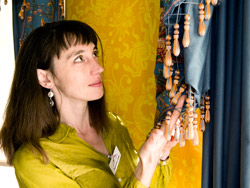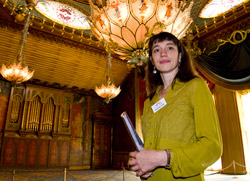- 8 December 2008
Alexandra studies colourful past of Royal Pavilionís dazzling decor

Alexandra Loske in the Yellow Bow Rooms, in Brighton's Royal Pavilion

Alexandra in the Royal Pavilion's flamboyant Music Room
There's more to the glorious opulence of Brighton's Royal Pavilion than meets the eye, says University of Sussex student Alexandra Loske, who is researching the iconic building's exotic colour scheme.
Alexandra, who is studying for a doctorate part-time in Art History at Sussex, was awarded a five-year part-time scholarship by the Arts and Humanities Research Council (AHRC) to conduct her research into the late 18th-century and early 19th-century interiors at the Royal Pavilion, Brighton, in collaboration with Brighton Museum and Art Gallery.
The AHRC Collaborative Doctoral Awards encourage academic and practical work. Universities and other institutions (such as museums and historic buildings) jointly supervise a student on a research topic. For Alexandra, this has meant access to the wall painting, fabrics, carpets, ornamentation and other fixtures of the Pavilion, as well as extensive archive resources and staff expertise.
Nearly one year into her research, Alexandra is delighted to have the opportunity to work in the Pavilion. She says: "It's been wonderful, digging through the archives, old account books, original wallpaper fragments and working with the Pavilion's conservation team."
Particular pleasures have included studying Royal correspondence relating to the decor and investigating the scientific processes behind creating pigments such as the magnificent chrome yellow used in one of the principal bedroom suites.
Her research focuses particularly on the influence of colour theory, which was taken up by European Romantics such as the German writer Goethe and influenced English artists such as Turner, who were fascinated by the possible effect colour has on human moods and emotions.
Alexandra says: "The Pavilion is very important in the history of colour theory, as it was the ultimate pleasure dome, designed to impress and dazzle. It's a sensory experience - on entering, you are received in rooms that progress from subdued and formal creams and pale greens to strong reds, blues and yellows, the colours becoming more intense and dazzling in grand social spaces such as the banqueting hall and music room."
The Royal Pavilion, a seaside retreat for the Prince Regent, later George IV - was developed into an Indian-style domed palace by the architect John Nash in the early 19th Century. The exotic interiors, so influenced by the Orientalism of the period, were the work of interior designers John and Frederick Crace and of the elusive Robert Jones, some of whose original design sketches are currently on show in the Pavilion.
Alexandra says: "The Prince Regent spent a lot of time - and vast amounts of money - consulting on colours and fabrics and decorative items for his palace. He was influenced by his advisors, by fashion and by colour theory, but it also reflects his flamboyant personality. He went over the top with everything. Every effort and expense was made to make the surroundings glitter, glisten and sparkle - ceramics, gilt, mirrors, skylights, polished surfaces and lots of trompe l'oeil - cast-iron banisters made to look like oriental bamboo, for example. The Pavilion is a unique example of extravagant Orientalism in Britain."
Alexandra hopes that her studies will eventually be turned into a book.
Notes for editors
For photos, interviews etc, please contact the University of Sussex Press office (contact details below).
- Photography arranged by kind permission of the Royal Pavilion and Museums, Brighton. See http://www.royalpavilion.org.uk/
- Arts & Humanities Research Council: Each year the AHRC provides approximately £100 million from the Government to support research and postgraduate study in the arts and humanities, from archaeology and English literature to design and dance. In any one year, the AHRC makes approximately 700 research awards and around 1,000 postgraduate awards. Awards are made after a rigorous peer review process, to ensure that only applications of the highest quality are funded. Arts and humanities researchers constitute nearly a quarter of all research-active staff in the higher education sector. The quality and range of research supported by this investment of public funds not only provides social and cultural benefits but also contributes to the economic success of the UK. www.ahrc.ac.uk
- The University of Sussex has several DPhil students holding AHRC studentships, which are awarded every year with the aim of encouraging collaboration between universities and non-academic institutions and businesses :
Victoria and Albert Museum: Jane Eade and Elaine Tierney have worked with the team on the forthcoming 2009 Baroque Exhibition at the V&A, London;
National Trust: lden Gregory is working on the 15th-century archbishop's palace at Knole, in collaboration with the National Trust; Edward Town is working on the 17th-century interiors of Knole, in collaboration with the National Trust
British Museum: Daniel Howells is researching the British Museum's collection of Late Antique gold glass.
Brighton Museum and Art Gallery: Claire Wintle is working on collections of material from the former British colonies at the Brighton Museum, gathered by those who lived and worked there, in collaboration with the Brighton Museum and Art Gallery
For more information about Art History at Sussex see: http://www.sussex.ac.uk/arthistory/
University of Sussex Press office contacts: Maggie Clune, Jacqui Bealing and Danïelle Treanor. Tel: +44 (0) 1273 678 888 or email press@sussex.ac.uk